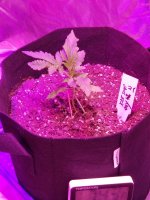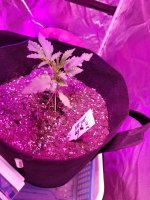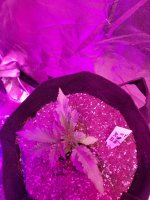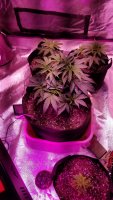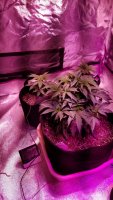What Cav said! You could put lights at 30” now and let plants grow until they are about 24” from the light and that should work great for your light and plants this size. Use your new growth that comes out as your measure. That’s one benefit about plants that are young...if you course correct you can see how much better the new growth looks and go from there.
Navigation
Install the app
How to install the app on iOS
How To Use Progressive Web App aka PWA On 420 Magazine Forum
Note: This feature may not be available in some browsers.
More options
You are using an out of date browser. It may not display this or other websites correctly.
You should upgrade or use an alternative browser.
You should upgrade or use an alternative browser.
First Grow! 1500W COB LED All Tips And Advice Wanted
- Thread starter Mikesem420
- Start date
Orlando Scout
Member
Let us know how it goes if it's not that we will brainstorm and get you a solution!
ddGreenThumb
Well-Known Member
Just tacking this on to what everyone else is saying. That 12" distance is more like the minimum, for example, your plants vertical growth has reached the point where you can't raise the lights any higher. In my tent with a
600w led panel I keep my plants between 25-30" away. Those LEDs are super powerful and easy to underestimate the output. I absolutely FRIED some of my seedlings learning this lesson the hard way.
And I'm not sure what your pH situation is, but if you don't have a GOOD pH meter... GET IT! lol... Moving away from my lights and getting my pH right really turned things around for me so hopefully this helps you!
600w led panel I keep my plants between 25-30" away. Those LEDs are super powerful and easy to underestimate the output. I absolutely FRIED some of my seedlings learning this lesson the hard way.
And I'm not sure what your pH situation is, but if you don't have a GOOD pH meter... GET IT! lol... Moving away from my lights and getting my pH right really turned things around for me so hopefully this helps you!
- Thread starter
- #24
Mikesem420
Well-Known Member
Heres a little update for anyone who's interested I got some bloom city calmag and I gave all of the plants a very low 1/4 strength feeding of big bloom and orca for roots was only like 145ppm unfortunately I had an accident while raising up the lights luckily my babies bounced right back after having the light fall on her smh seems to be fine now this is day 21 update have some pics of the growth here
Attachments
- Thread starter
- #25
Mikesem420
Well-Known Member
The solo cups are the shark the smart pot is the sour seems to have liked the 1/4 strength nutrients
Attachments
Mikesem420 good thing you measured actual power out of your lights. Those import fan box style lights often exaggerate wattage kind of like cheap stereos. Rate based on power potential of LED and not actual fixture power. Then how efficient those LEDs are is a different thing.
2 reasons to move your lights: 1) You can't dim your lights so you move it away to reduce par during veg phase 2) Heat at plant leaf
Best thing is to get a LED light that you can dim and then get light really close to plant and track the plant, this will improve your thermal load and longevity of the light and dial in the perfect amount of par. Then make sure you measure either with a spot probe or an infrared thermometer (looks like a laser tag gun) the temperature at your leaves.
Most credible temp data you find is based on leaf temperature and not ambient because in nature you can have colder ambient but warm leaf if infrared is intense because of altitude, time of day, time of year, etc. Kinda like all it matters is how warm you are and not the temp outside because maybe you have a space heater or a sweatshirt. So track plant temp because lights could be locally heating plant and room temp only tells you the temp at your sensor not your plants.
You will want lower PAR during veg and just about as much as you can get during flower to the point where you might need to supplement with CO2. The heights that are being recommended to you may work just fine but heights vary based the optics of the fixture (does it focus downward or shine at 120 degrees), how efficient your light is (600w of one LED may be a different brightness of 600W of another), and again temperature.
Best get a par meter. If you get a full spectrum white LED fixture you can sorta cheat with a flux meter if you get one dialed for LED and then follow what people are saying in the forums but you're best to get a par meter. Take a look at your PAR meter data sheet and make sure it captures evenly the PAR spectrum. For instance I use Apogee and their previous gen "LED" one dropped out on the red end of the spectrum so if you had a light that supplements at 660nm red it would not be picked up by the meter. I use their most current one.
Lumens is visible white light. Your eye favors the yellow white light and to some degree green which is why an equal power red and green light, green looks brighter. Its how we're programmed as humans. So white lights are on a lumen rating for how humans perceive. So if you have a lux meter (lumens on a surface per given area) and you have those blurple LEDs you can see how the lux meter will miss most of the light coming out of your fixture. This can give you confusing results between fixtures where brightness and performance don't correlate.

2 reasons to move your lights: 1) You can't dim your lights so you move it away to reduce par during veg phase 2) Heat at plant leaf
Best thing is to get a LED light that you can dim and then get light really close to plant and track the plant, this will improve your thermal load and longevity of the light and dial in the perfect amount of par. Then make sure you measure either with a spot probe or an infrared thermometer (looks like a laser tag gun) the temperature at your leaves.
Most credible temp data you find is based on leaf temperature and not ambient because in nature you can have colder ambient but warm leaf if infrared is intense because of altitude, time of day, time of year, etc. Kinda like all it matters is how warm you are and not the temp outside because maybe you have a space heater or a sweatshirt. So track plant temp because lights could be locally heating plant and room temp only tells you the temp at your sensor not your plants.
You will want lower PAR during veg and just about as much as you can get during flower to the point where you might need to supplement with CO2. The heights that are being recommended to you may work just fine but heights vary based the optics of the fixture (does it focus downward or shine at 120 degrees), how efficient your light is (600w of one LED may be a different brightness of 600W of another), and again temperature.
Best get a par meter. If you get a full spectrum white LED fixture you can sorta cheat with a flux meter if you get one dialed for LED and then follow what people are saying in the forums but you're best to get a par meter. Take a look at your PAR meter data sheet and make sure it captures evenly the PAR spectrum. For instance I use Apogee and their previous gen "LED" one dropped out on the red end of the spectrum so if you had a light that supplements at 660nm red it would not be picked up by the meter. I use their most current one.
Lumens is visible white light. Your eye favors the yellow white light and to some degree green which is why an equal power red and green light, green looks brighter. Its how we're programmed as humans. So white lights are on a lumen rating for how humans perceive. So if you have a lux meter (lumens on a surface per given area) and you have those blurple LEDs you can see how the lux meter will miss most of the light coming out of your fixture. This can give you confusing results between fixtures where brightness and performance don't correlate.
- Thread starter
- #27
Mikesem420
Well-Known Member
That is exactly why I put my first light the 600w cob with reflector cone on the meter I had read about alot of false claims without the bloom setting on it's only putting out 75w then I found the Chinese "1500w cob white light" I was very skeptical at first but it had great reviews all the other box fan cobs like this didnt come close to an actual 300w which I'm really impressed with I have a dr.meter lux meter but I know that's not very accurate thanks for all this info I'm definatley going to order a thermal gun and try to get a better idea of what's going on maybe a par meter if I can affoard it that way totally makes sense with the thermal probe this helped me alot I'll get more detailed info on the lights and take temp readings an get back to you see what you thinkMikesem420 good thing you measured actual power out of your lights. Those import fan box style lights often exaggerate wattage kind of like cheap stereos. Rate based on power potential of LED and not actual fixture power. Then how efficient those LEDs are is a different thing.
2 reasons to move your lights: 1) You can't dim your lights so you move it away to reduce par during veg phase 2) Heat at plant leaf
Best thing is to get a LED light that you can dim and then get light really close to plant and track the plant, this will improve your thermal load and longevity of the light and dial in the perfect amount of par. Then make sure you measure either with a spot probe or an infrared thermometer (looks like a laser tag gun) the temperature at your leaves.
Most credible temp data you find is based on leaf temperature and not ambient because in nature you can have colder ambient but warm leaf if infrared is intense because of altitude, time of day, time of year, etc. Kinda like all it matters is how warm you are and not the temp outside because maybe you have a space heater or a sweatshirt. So track plant temp because lights could be locally heating plant and room temp only tells you the temp at your sensor not your plants.
You will want lower PAR during veg and just about as much as you can get during flower to the point where you might need to supplement with CO2. The heights that are being recommended to you may work just fine but heights vary based the optics of the fixture (does it focus downward or shine at 120 degrees), how efficient your light is (600w of one LED may be a different brightness of 600W of another), and again temperature.
Best get a par meter. If you get a full spectrum white LED fixture you can sorta cheat with a flux meter if you get one dialed for LED and then follow what people are saying in the forums but you're best to get a par meter. Take a look at your PAR meter data sheet and make sure it captures evenly the PAR spectrum. For instance I use Apogee and their previous gen "LED" one dropped out on the red end of the spectrum so if you had a light that supplements at 660nm red it would not be picked up by the meter. I use their most current one.
Lumens is visible white light. Your eye favors the yellow white light and to some degree green which is why an equal power red and green light, green looks brighter. Its how we're programmed as humans. So white lights are on a lumen rating for how humans perceive. So if you have a lux meter (lumens on a surface per given area) and you have those blurple LEDs you can see how the lux meter will miss most of the light coming out of your fixture. This can give you confusing results between fixtures where brightness and performance don't correlate.

Glad to help. Other thing you can do is borrow someones real par meter and so long as you don't change your lights and your lux meter you can have a translation table. ie this lux = this par .
When I first got in to this I bought the Hydrofarm meter on Amazon and got terrible PAR results and couldnt figure out why until I I looked up sensor ranges which I knew to look for when I got in to LED 7 years ago when the meters at the time were calibrated for fluorescent and didn't register for LED wavelengths. Hydrofarm didnt even publish their meter sensor calibrations. It now looks like they do publish a chart but I've read bad reviews with LED still. Get what you pay for I think.
Here is what a proper meter company would provide that does meters for a living and not private labeling products: How to Correct for Spectral Errors of Popular Light Sources . Licor is probably the best but I went with apogee because it is pretty close for a third the cost if you get usb and just hook in to laptop. Sun system meter isn't great for LED either. If you're using HPS then use whatever meter and same advice with CMH to some degree. But yeah try to borrow someones good meter.
Here is what someone recommends in umol/m2/s: Cuttings: 75-150 / Veg: 300-600 / Flower 600+
Images go: Apogee, Sun System, Licor



When I first got in to this I bought the Hydrofarm meter on Amazon and got terrible PAR results and couldnt figure out why until I I looked up sensor ranges which I knew to look for when I got in to LED 7 years ago when the meters at the time were calibrated for fluorescent and didn't register for LED wavelengths. Hydrofarm didnt even publish their meter sensor calibrations. It now looks like they do publish a chart but I've read bad reviews with LED still. Get what you pay for I think.
Here is what a proper meter company would provide that does meters for a living and not private labeling products: How to Correct for Spectral Errors of Popular Light Sources . Licor is probably the best but I went with apogee because it is pretty close for a third the cost if you get usb and just hook in to laptop. Sun system meter isn't great for LED either. If you're using HPS then use whatever meter and same advice with CMH to some degree. But yeah try to borrow someones good meter.
Here is what someone recommends in umol/m2/s: Cuttings: 75-150 / Veg: 300-600 / Flower 600+
Images go: Apogee, Sun System, Licor



- Thread starter
- #29
Mikesem420
Well-Known Member
So I dont wana post anything that's not allowed I'm by no way promoting these lights I'm only posting the info I have to get better answers the 600w is a motansun and the white light is a yueme 1500w cob the yueme is 120° but it has 5 300w cobs the 600w motansun has the 90° reflector cone around the cob plus rgb leds from what I've seen the 1500w is way more intense idk if that means better or not some one said on amazon that its has starburst chips.. I took some better pictures of them just incase someone had used them an had bad results
I have 5-6 nodes on my triple sour I topped it for the first time i also added plant ties to the larger branches I'm going to try a combination of lst and toping for my first grow is it to soon to have topped it I read you can start right around 5-6 nodes
I have 5-6 nodes on my triple sour I topped it for the first time i also added plant ties to the larger branches I'm going to try a combination of lst and toping for my first grow is it to soon to have topped it I read you can start right around 5-6 nodes
If you have the time I'd do more tops than 6.
Curious question, how much weight can your tent hold?
Looked both those lights up. You probably want 120 degrees if you're using a box light so light can spread out quickly. Just keep it tight to the lights. I'm not sure what your plan is for balancing the room with 200W ("1500W") and a 95W ("600W") since one is double the other. Or you just say whatever and know that plants will grow bigger under 200W. I'd leave all the switches on for veg, full spectrum, and bloom. These lights are not smart lights that hold the output the same and re-balance the spectrum when you flip those switches. They just increase or decrease output so I'd leave them on all the time. Since there is plenty of blue in there the added red will just cause them to stretch a little more but is fine. Remember in the wild these things get full spectrum all day every day. Blue just helps veg growth, red flower growth and favoring those can help you manipulate but in this case I'd leave everything on.
For anyone curious because we were talking about plant heights, I have a buddy in the LED industry with me and he made me a prototype that was 500W actual and I kept it 6" off my plants with and got more than 1.5g/w. Couldn't feel heat at 6". But anyways I'll leave this to other people to comment so you get some diversity. Good luck!
Curious question, how much weight can your tent hold?
Looked both those lights up. You probably want 120 degrees if you're using a box light so light can spread out quickly. Just keep it tight to the lights. I'm not sure what your plan is for balancing the room with 200W ("1500W") and a 95W ("600W") since one is double the other. Or you just say whatever and know that plants will grow bigger under 200W. I'd leave all the switches on for veg, full spectrum, and bloom. These lights are not smart lights that hold the output the same and re-balance the spectrum when you flip those switches. They just increase or decrease output so I'd leave them on all the time. Since there is plenty of blue in there the added red will just cause them to stretch a little more but is fine. Remember in the wild these things get full spectrum all day every day. Blue just helps veg growth, red flower growth and favoring those can help you manipulate but in this case I'd leave everything on.
For anyone curious because we were talking about plant heights, I have a buddy in the LED industry with me and he made me a prototype that was 500W actual and I kept it 6" off my plants with and got more than 1.5g/w. Couldn't feel heat at 6". But anyways I'll leave this to other people to comment so you get some diversity. Good luck!
- Thread starter
- #31
Mikesem420
Well-Known Member
Ya so when I ordered the first one the 600w I had thought it was alot more powerful it had really good reviews once I learned that wasnt the case I immediately ordered the other one that 600w light is nothing special obviously I'm learning..
What do you mean more than 6? I plan on doing throught veg i was worried I may have started to soon but I'm at 5-6 nodes.
So would you say that it would prolly be better to just use the true 300w box style cob light alone since its 120° I just thought that since I had it the 95 watt 90° would only add to my yields but if it's going to cause one side to grow less than the other I'm not familiar with the concept of balancing I was under the impression more is better.
I could also order a second yueme so I'm running 600w of tru white light if you have any recommendations of what the best light for my 5x5x84 I'm not sure about the amount of weight it can hold but it's an apollo horticulture tent again for any one who may be concerend I am NOT promoting anything this is all so people can give me better informed answer thanks! You guys are such a great help I'm very appreciative
Right after I did these tests the veg setting on the 600w burned out ive only be running it for 4 weeks 18-6 unbelievable thankfully amazon is great with returns smh..
What do you mean more than 6? I plan on doing throught veg i was worried I may have started to soon but I'm at 5-6 nodes.
So would you say that it would prolly be better to just use the true 300w box style cob light alone since its 120° I just thought that since I had it the 95 watt 90° would only add to my yields but if it's going to cause one side to grow less than the other I'm not familiar with the concept of balancing I was under the impression more is better.
I could also order a second yueme so I'm running 600w of tru white light if you have any recommendations of what the best light for my 5x5x84 I'm not sure about the amount of weight it can hold but it's an apollo horticulture tent again for any one who may be concerend I am NOT promoting anything this is all so people can give me better informed answer thanks! You guys are such a great help I'm very appreciative
Right after I did these tests the veg setting on the 600w burned out ive only be running it for 4 weeks 18-6 unbelievable thankfully amazon is great with returns smh..
Attachments
Oh I see what you mean. I was just looking at how much space you had between plants and was saying I'd do more than 5-6 nodes but you were talking about the timing of it. Yeah I'd wait until you have at least a foot of stem coming out of the ground but I'm sure a lot of people have opinions of that. My thought process is helps develop roots and has a thicker stalk to deliver water and nutrients which will allow plant to grow bigger. Although I've seen some short little shrubs pull a lot of weight. Up for debate, but you'll learn what you like and don't like on this first one and keep improving!
Looked up your tent it looks like the top is steel cross bars. Can't tell about the vertical uprights but it seems pretty sturdy.
Ha oh the chinese box lights. Get what you pay for. Glad Amazon was good at taking it back!
More is always better I was just trying to point out that if you put them side by side the center would be like a 4, one side like a 2 and the other like a 1 on relative intensity. I was just pointing out an imbalance so you could understand why some plants might grow differently from the others. I'd maybe put the brightest in the center and use the lower output as a roaming light. Like say for instance after the flip if one part of it is struggling you can move it over there to fill in to help bring everything even again. Up to you, whatever works best and makes sense to you.
Looked up your tent it looks like the top is steel cross bars. Can't tell about the vertical uprights but it seems pretty sturdy.
Ha oh the chinese box lights. Get what you pay for. Glad Amazon was good at taking it back!
More is always better I was just trying to point out that if you put them side by side the center would be like a 4, one side like a 2 and the other like a 1 on relative intensity. I was just pointing out an imbalance so you could understand why some plants might grow differently from the others. I'd maybe put the brightest in the center and use the lower output as a roaming light. Like say for instance after the flip if one part of it is struggling you can move it over there to fill in to help bring everything even again. Up to you, whatever works best and makes sense to you.
- Thread starter
- #33
Mikesem420
Well-Known Member
I see what ya mean now. So my plan since this stupid light broke is to return it and then replace it with another 1500w cob if theres any recommendations on sponsored ones that might be a good addition 200$ or less I forgot to mention I have a 150w sunsystem hps that I started with I stopped running it when I got the LEDs but I could easily set it back up if you think mixing led an hps might produce better results
Since your LEDs aren't getting to that point where you need supplemental CO2 more light is better. Don't introduce your hps till about 2 days before you're ready to flower since you probably have enough light during veg if it is really putting out 300w. (again watts is a bad measurement but a crude gauge in a pinch since LED efficiency varies wildly). You'll want to introduce it a couple days before the switch because the plant needs to get used to the new spectrum its seeing. Professional growers experience shock when they go from LED veg to HPS flower rooms because the plant is used to going about its business with 1 input and then that input up and changes completely. I could get in to it on a biological level but would be boring ha.
I've posted extensively elsewhere about this. LED is always better because of spectrum and efficiency but if you're not getting more than 600umol/m2/s at your canopy and have a high intensity discharge light (cmh/hps) then use it and combine because more light is better if you can swing the power. Maybe if you got another box light you could set it up in like a triangle? A good LED, emphasis on good, should about halve a HPS in watts with same output.
I've posted extensively elsewhere about this. LED is always better because of spectrum and efficiency but if you're not getting more than 600umol/m2/s at your canopy and have a high intensity discharge light (cmh/hps) then use it and combine because more light is better if you can swing the power. Maybe if you got another box light you could set it up in like a triangle? A good LED, emphasis on good, should about halve a HPS in watts with same output.
- Thread starter
- #35
Mikesem420
Well-Known Member
(Day 31 update) The Triple Sour large one in the middle is in week 2 of veg from left to right the 2 white shark are week 1 and the bag seed kush is also week 1. I also transplanted up into smart pots the sour from a 3 - 5gal the shark into 1 gal starters now my girls just need to fill into there new skirts!
Attachments
- Thread starter
- #36
Mikesem420
Well-Known Member
Update: day 37
Everything's looking pretty good here sour and white shark are looking very healthy only issue I've been having is temp since I added a 3rd led it's another cob with more red spectrum for flowering I also did a little hack an put a lens on one of the plain 3500k cobs an it seems to have made a big difference in the efficiency all the light from that cob is concentrated downward now I'm going to order more and do the rest cheap upgrade. I just ordered a bigger 6inch exhaust fan the temps in the tent are pushing 78-80 with the door zipped up I have a 4inch ac infinity fan right now for exhaust i think it just doesnt have enough cfm so tomorrow I'm gona switch that to my intake and the 6inch with filter exhausted into the next room.
Everything's looking pretty good here sour and white shark are looking very healthy only issue I've been having is temp since I added a 3rd led it's another cob with more red spectrum for flowering I also did a little hack an put a lens on one of the plain 3500k cobs an it seems to have made a big difference in the efficiency all the light from that cob is concentrated downward now I'm going to order more and do the rest cheap upgrade. I just ordered a bigger 6inch exhaust fan the temps in the tent are pushing 78-80 with the door zipped up I have a 4inch ac infinity fan right now for exhaust i think it just doesnt have enough cfm so tomorrow I'm gona switch that to my intake and the 6inch with filter exhausted into the next room.
Attachments
-
 20181107_122842.jpg553.8 KB · Views: 71
20181107_122842.jpg553.8 KB · Views: 71 -
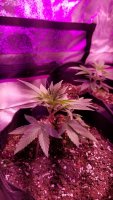 20181106_144903.jpg545.5 KB · Views: 67
20181106_144903.jpg545.5 KB · Views: 67 -
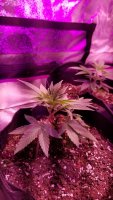 20181106_144903.jpg545.5 KB · Views: 71
20181106_144903.jpg545.5 KB · Views: 71 -
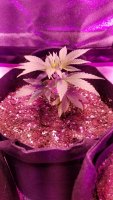 20181106_144851.jpg574.4 KB · Views: 72
20181106_144851.jpg574.4 KB · Views: 72 -
 1541612685090756879902061825144.jpg493.3 KB · Views: 80
1541612685090756879902061825144.jpg493.3 KB · Views: 80 -
 15416127430647824277437243350098.jpg473.6 KB · Views: 74
15416127430647824277437243350098.jpg473.6 KB · Views: 74 -
 15416127940147129831992387833570.jpg490.7 KB · Views: 73
15416127940147129831992387833570.jpg490.7 KB · Views: 73 -
 15416128207611939815539361504197.jpg466.6 KB · Views: 70
15416128207611939815539361504197.jpg466.6 KB · Views: 70
Nice! Optic will cut total light because it is filtering through a medium but will likely increase ppfd on your plants because a lot of it isn't wasted blasting the side of your tent. Good call.Update: day 37
Everything's looking pretty good here sour and white shark are looking very healthy only issue I've been having is temp since I added a 3rd led it's another cob with more red spectrum for flowering I also did a little hack an put a lens on one of the plain 3500k cobs an it seems to have made a big difference in the efficiency all the light from that cob is concentrated downward now I'm going to order more and do the rest cheap upgrade. I just ordered a bigger 6inch exhaust fan the temps in the tent are pushing 78-80 with the door zipped up I have a 4inch ac infinity fan right now for exhaust i think it just doesnt have enough cfm so tomorrow I'm gona switch that to my intake and the 6inch with filter exhausted into the next room.
- Thread starter
- #38
Mikesem420
Well-Known Member
Is it just me or is tending to your plants while jamming out to whatever you like with a fat raw of some fire bud green crack in my case the most therapeutic thing in the world! hahah
- Thread starter
- #39
Mikesem420
Well-Known Member
(Day 41) So happy looks like all my babies are doing great the sour is growing so fast the shark is starting to catch up seems to be loving the nutes! My only issue is the mystery kush bag seeds right from the start it was ugly think I'll leave it a few more weeks if doesnt improve I'm gona remove it..
Attachments
TriangleCheese
Well-Known Member
Just checking in for later.  and good luck with your first grow Mike.
and good luck with your first grow Mike.
 and good luck with your first grow Mike.
and good luck with your first grow Mike.


